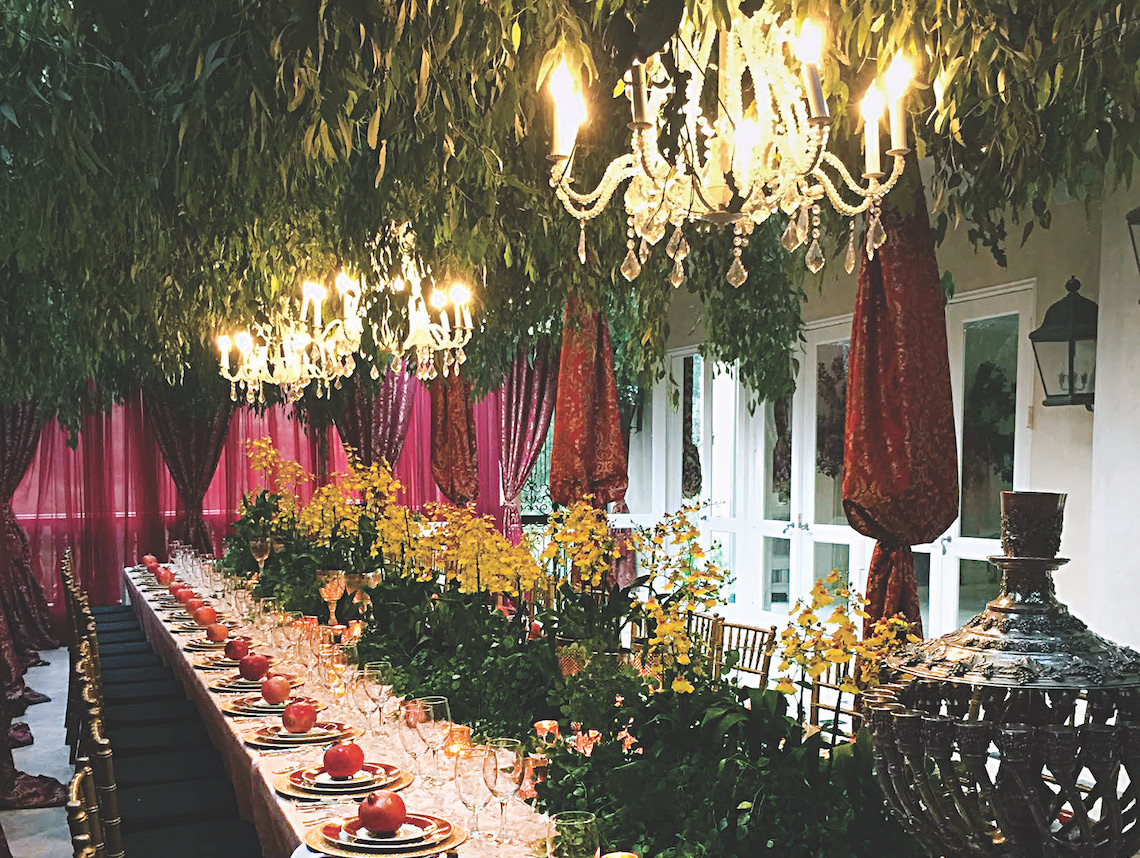
Dina and Fred Leeds like to entertain. And they have a large, beautiful home in the hills of West Los Angeles in which to do so. It is filled with art and antiques, including a Harley-Davidson motorcycle that once belonged to Pat Boone that’s parked conspicuously in the entryway.
“We celebrate all life occasions to the fullest,” Dina said.
This includes Sukkot.
Ever since they can remember, the couple, who have seven children, three of whom still live at home, have erected a sizable sukkah they designed themselves. The size of a large school bus, it fills nearly the entire balcony outside the game room on the lower level of their residence. In recent years, it has featured “walls” fashioned from rich, wine-colored fabric. In the past, the walls were a beautiful, cream color.
In addition to its size, the Leeds’ larger sukkah is distinguished by several other features. It has three chandeliers and a long, linen-topped table with seating for 40. Dina orders “Dancing Lady” orchids every year to dress it up. “Every single petal looks like a dancing lady,” she said. “I enjoy looking at them when the table vibrates.”
Fred is the principal of Fred Leeds Properties, a real estate company with holdings mainly in Southern California and Arizona, and Dina is vice president. They are known for their philanthropic work with organizations such as the United States Holocaust Museum, Magen David Adom (Israel’s emergency medical response network), StandWithUs and the Jewish Federation Real Estate Principals Organization.
In recent years, they have added a second sukkah next to their kitchen, though this one is far more modest.
Dina, who was born in Egypt but moved to Los Angeles when she was a toddler, credits Chanah Rachel Schusterman, a Los Angeles-based educator who teaches a weekly class for women, for the inspiration — a second sukkah where their children could eat a quick breakfast before school.
“I copied her,” Dina said. “I thought it was so smart: making the mitzvah easy and convenient.”
Given one of Fred’s earliest memories of the holiday, it’s a wonder he didn’t abandon Sukkot altogether. When he was 12, he was caught eating fruit off the sukkah at Sinai Temple in Westwood.
“I was hungry,” he said.
Temple leadership was not amused. “I got kicked out,” he recalled.
Of their own sukkah, Fred said, “I love being under the stars and smelling the eucalyptus branches and being with friends.” The eucalyptus branches, which make up the roof of the sukkah, come from trees in their yard.
One tradition they keep: a pomegranate at every place. One year, Dina counted the number of seeds in the fruit. She wanted to confirm the lore she had heard since she was a child, that the number was equivalent to the total number of mitzvot (613) in the Torah.
“When we got to 943, I was devastated,” she recalled. She called her friend, Rabbi Chaim Mentz of Chabad of Bel Air. “He said, ‘Oh, Dina, the Torah doesn’t say that. It’s mistranslated. What it does say is, your mitzvot should be plentiful as the seeds of a pomegranate.’ ”
Whatever the number of seeds, the pomegranates have remained.
One practice that might surprise new visitors to the Leeds’ Jewish celebrations is a Sephardic tradition — one they maintain at Shabbat dinners — of throwing pieces of challah.
“When you pass bread to another man, you are subordinating him to you,” Dina said, explaining that throwing the challah instead symbolizes that no man provides for any other man. Rather, “a man’s sustenance comes from God, in the same ways that manna dropped from the heavens. … [Guests] are always pleased at what a good arm [Fred] has and what a good catcher I am.”
One thing the Leeds’ sukkah does not have is anything on the walls. “It’s traditional for Chabad not to decorate the walls of the sukkah,” said Dina, a self-proclaimed “shul hopper,” along with her husband. “It’s a beautiful idea,” she added. “The guests who enter the sukkah are your decorations.”
Among the hundreds of guests who have joined the Leeds over the years in their sukkah is Orly Halevy of West Hollywood, a professional photographer.
“I never saw a sukkah like this in my life,” said the Israeli-born Halevy, who has seen her fair share. “It is lavish. But it’s not over the top. It’s from the heart. … It’s a very warm atmosphere. They don’t do it to show off. This is their style.”
While it would be easy to focus entirely on the dramatic setting of the sukkah — nestled in the hills and surrounded by mature trees — as well as its fantastic size and beautiful table, Dina said that, ultimately, their tradition is all about observance.
“I love the beauty and wisdom of our Torah,” she said. “It becomes experiential in the sukkah.”






















 More news and opinions than at a Shabbat dinner, right in your inbox.
More news and opinions than at a Shabbat dinner, right in your inbox.